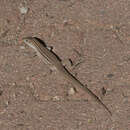ar
الأسماء في صفحات التنقل


Common predators of C. sonorae are birds, especially the roadrunner, and many reptiles which they may encounter in burrows. They do have the ability of autotomizing their tails (Routman and Hulse 1984). This may help in the evasion of some predation attempts.
US Federal List: no special status
CITES: no special status
IUCN Red List of Threatened Species: least concern
Lizards are useful in the control of insect pests; they fill an important ecological niche as small predators in a number of aridland habitats.
This lizard feeds largely on small animals with an average length of 1.28 mm numerically and 1.80 mm volumetrically (Goldberg et al. 1997). Prey is mostly insects and other invertebrates. In captivity they have eaten chicken mash (Porter et al. 1994).
Cnemidophorus sonorae ranges from southeastern Arizona to northeast Sonora, and east into New Mexico (Case 1990, McAllister 1992). This lizard prefers elevations between 3200 and 8000 feet (Goldberg et al. 1997).
Biogeographic Regions: nearctic (Native )
These lizards inhabit semi-arid to arid habitats within their range in western North America. These habitats include oak woods and oak savanna, streamside woods, desert grasslands, and desert scrublands (Goldberg et al. 1997, Case 1990, Routman and Hulse 1984, Stebbins 1985).
Terrestrial Biomes: desert or dune
Snout to vent length is 62-87 mm.
This lizard has six dorsal stripes with five to eight dorsal scales between the middorsal stripes. Overall color is blackish brown or reddish, with white, tan or yellowish spots dorsally and the tail is often a dull orange-tan that tapers to olive at the tip. The belly is cream-colored, and unmarked (Stebbins 1985).
Cnemidophorus sonorae is a unisexual, all-female species that breeds by parthenogenesis (Goldberg et al. 1997, Routman and Hulse 1984, Porter et al. 1994). Ovulation is often stimulated by "pseudocourtship" among the females; the unfertilized eggs develop into hatchlings that are genetically identical to their mothers. Their reproductive season occurs from mid May into late July. Two or three clutches of three to four eggs may be produced annually. Shelled oviductal eggs have an average length of 14.25 mm and a mass of 0.53 g (Routman and Hulse 1984). Eggs are buried in the ground; based on studies of related species, the incubation period is probably around 40 to 60 days.
The Sonoran spotted whiptail (Aspidoscelis sonorae) is a parthenogenic[2] species of teiid lizard found in Arizona and New Mexico in the United States, and Mexico.[3]
The Sonoran spotted whiptail (Aspidoscelis sonorae) is a parthenogenic species of teiid lizard found in Arizona and New Mexico in the United States, and Mexico.
Aspidoscelis sonorae Aspidoscelis generoko animalia da. Narrastien barruko Teiidae familian sailkatuta dago.
Aspidoscelis sonorae Aspidoscelis generoko animalia da. Narrastien barruko Teiidae familian sailkatuta dago.
Aspidoscelis flagellicauda est une espèce de sauriens de la famille des Teiidae[1].
Cette espèce est endémique des États-Unis. Elle se rencontre dans l'Arizona et le Nouveau-Mexique[1].
C'est une espèce parténogénique[1].